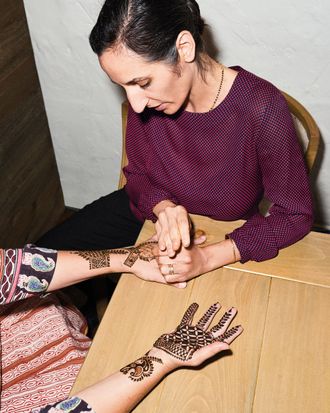
In our Ask the Experts series, New York Weddings gets tips and advice from professionals in disciplines from dress design to elopement planning.
Mangala Bühler-Rose
Founder of Mehndi NYC
The henna tradition goes back thousands of years. How do you make it feel modern?
Instead of the traditional intricate, lacy designs, I enjoy doing geometric henna with striking patterns ($350 a session), so that you can really see the lines in your wedding photos. A lot of brides are calling me directly and requesting simpler work. That definitely wasn’t the case earlier on. The family used to coordinate the ceremony, and then everyone wanted a say — it was like Say Yes to the Dress. Mothers wanted the bride to get whatever they had: “I had it up to my elbows, and I had paisley print, so you should have that.” I once had a bride whose future mother-in-law had all these ideas. When I went over, the bride met me in the lobby and said she just wanted a few bold designs.
What are some examples of these?
For one woman, on the pads of her fingers I did tribal yogic symbols: a cow’s hoofprint, because cows are considered auspicious in Hindu culture, and dots that symbolize lotuses, which denote beauty, as in old Indian literature where someone is described as having “lotus eyes.” But I painted these on like small individual tattoos — you wouldn’t normally see that kind of placement.
How do you design henna differently for cross-cultural weddings?
Roughly half of my brides are not of South Asian descent, so it’s common for them to ask me about ceremonial symbols and how to be respectful. For example, you wouldn’t put certain sacred symbols on your feet, because putting your foot on something is seen as disrespectful in some cultures. So if someone wanted something like Ganesha, the elephant god in Hinduism, I would say your hand or arm is cool, but not your feet or legs.
You are specific about using only natural ingredients. What’s your recipe?
Henna that contains PPD (p-phenylenediamine) — a key ingredient in permanent hair dye — can cause scarring. I’m never touching anything like that. I order organic powdered henna leaf from India and mix it with lemon juice or distilled water, organic sugar, and essential oils like organic Bulgarian lavender oil or tea-tree oil. The essential oils actually help the dye stay in the henna.
Any tips for a bride who has to return to the office and wants to remove the henna?
Henna permanently stains the stratum corneum — the very thin outermost layer of the skin. As it sheds, the henna fades. Exfoliating with something like the St. Ives apricot scrub can help the shedding process. I’ve also heard rubbing a raw potato on your skin works. I can’t back it up, but people swear by it.
347-422-7108; mehndinyc.com
Pro Tip
“For a bride doing two weddings, sometimes we’ll do heavy henna on her palms, to go with the Hindu wedding, and leave the outside of her hands bare, so she can match her jewelry to her white dress.”
*This article appears in the winter 2018 issue of New York Weddings.




